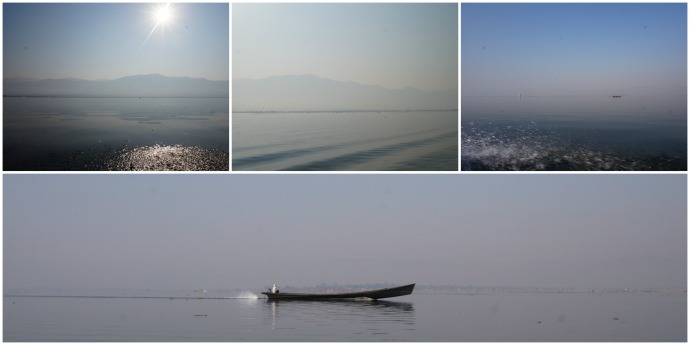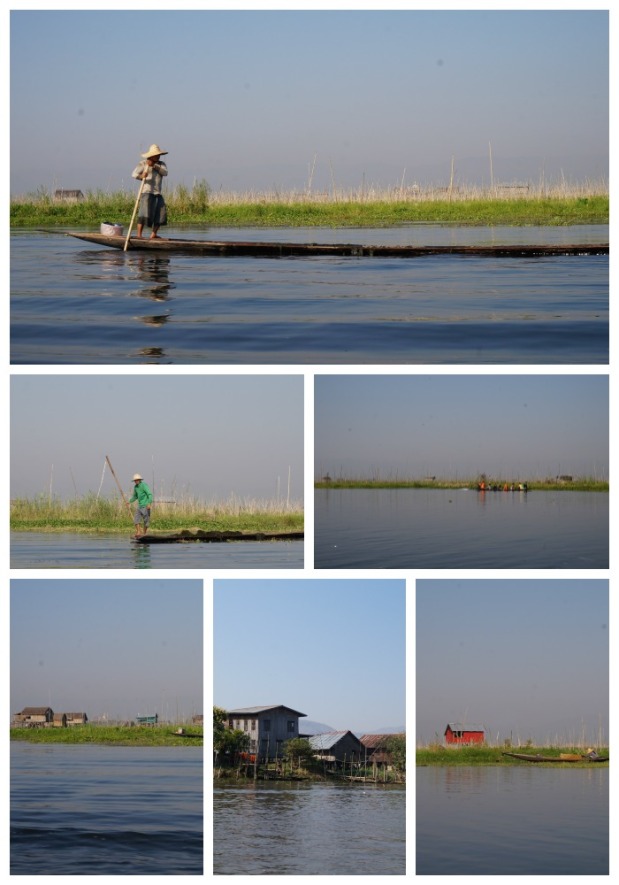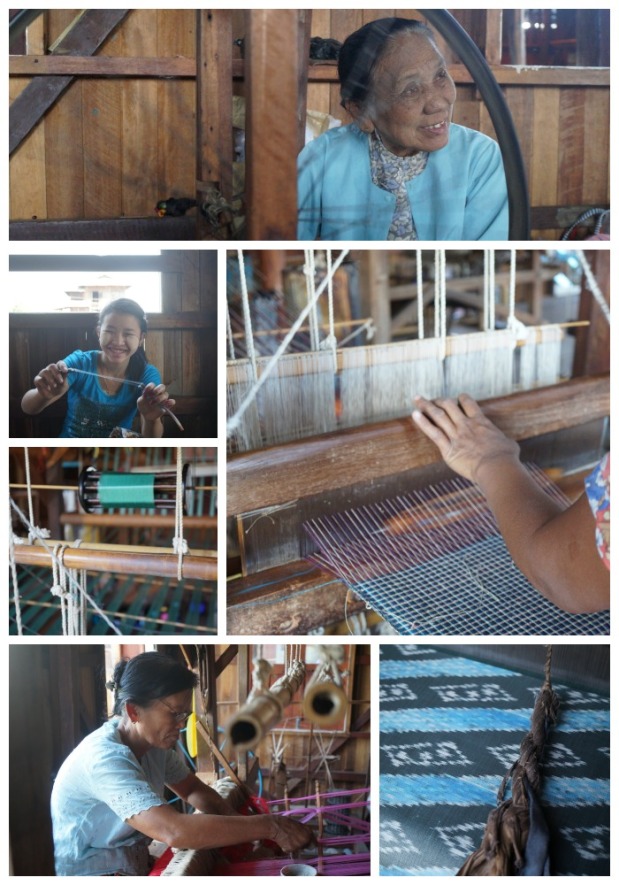A Tour of Inle Lake | Thoughts on Sustainability
A red and blue school bag hanging from a wooden post, reflected in the water. A woman, squatting on one of the wooden steps leading from the water up to her house, washing plates in a pale blue plastic bowl. The sound of pop music wafting in and out of earshot with the breeze. A tiny boy, standing at one end of a long wooden boat, carefully rowing between the houses. A man leaning over the side of his boat to trim his floating plants.
It was these everyday sights, these familiar things done in an unfamiliar setting, that I really loved about my boat tour of Inle Lake. There are only a few temples in the area to visit, a few markets, it’s seeing how life is lived on the water that draws people to the area. Yet even as I was appreciating all of this, I was aware that there was something off about the experience, something that was making me feel uncomfortable.
The whole purpose of travel, for me anyway, is to see how other people live their lives. There is nothing I love more than exploring an area of a city where people actually live and go about their daily lives; seeing where they shop, where they meet with friends, and where they live. Yet it is one thing for me to be quietly strolling streets, cup of coffee in one hand smiling and chatting to people, and quite another to be sat in one of the hundreds of boats which leave Nyangshwe harbour every morning, unable to interact at all with those I was observing.
Pretty much everyone who comes to the area does a boat tour of the lake at some point, and they are all very similar. They cover the same sort of sights, just in a slightly different order. They all cost the same – 18000 kyat for a boat which seats up to five people – and can be arranged through your guesthouse, or you can just go to the jetty at 8 / 8.30 in the morning and commandeer one.
I remember sitting up in bed the night before, looking at my Lonely Planet Guide to Myanmar, inside of which is a photograph of a fisherman on Inle Lake, rowing in the unique Intha-style: one leg wrapped around the ore, driving it through the water in a smooth motion. I thought how much I would love to get a similar photo, but I doubted there would be many, and as I don’t have a long lens on my camera I didn’t fancy my chances. How wrong was I! As we powered from the canal into the wider lake the next morning we were met by five or six fisherman, all dressed in traditional clothes, rowing with their legs. And they were all doing it purely for the sake of the tourists. Our boat pulled up alongside one. He rowed a few times with his legs so we could get a photo, then he crouched down and held up a fish that had clearly been out of the water for a while. Photos once again taken, he held out his hand for money.
It’s a tricky one. He clearly makes more money doing this than actually fishing, and you can’t judge him for that. He’s fulfilling a demand which is very much there – almost entrepreneurially. But it made me feel very uncomfortable – to have something that was once a natural part of their culture being played out as a sort of stage-show for tourists. I have a rule that I only take photographs of people I have had some sort of engagement with – be it a hello, a wave or eye contact at the very least – some sort of acquiescence from them that they don’t mind me taking their photo. But I couldn’t catch his eye, and aware there was only a limited time to do so – I took some photos without it. Yet while I may have got the shot I was after, they’re not photos I’m proud of.
Money exchanged, our boat sped up again, heading to the far south of the lake. The journey might have taken an hour, it might have taken two; I had very little idea of time. At the start the sky and the lake were the same hue of silver grey, both immaculately smooth, blending into one another with just a thin, barely distinguishable line the only indicator of where one ended and the other began. The mountains were just a hazy outline, off to one-side and in the distance: a cut-out of slightly darker paper pasted onto the sky. The throb of the engine drowned out all other noise, and spray fanned around us. It was chilly, we wrapped the tartan blankets provided over our knees.
The smoothness began to be broken by long, thin sticks, standing upright out of the water. Chunks of thick weed floated past. Then, as the sun rose that little bit higher, as quickly as if someone had flicked a switch, everything came into colour. Things that had appeared washed out and faded a few minutes before were suddenly shockingly bright. Lime green reed floated on the lake’s surface, which had darkened, turning into a metallic gunmetal grey. The sky meanwhile had softened into Babygro blue. Men, in red jumpers, purple shirts, brown trousers, leaned out of equally bright painted boats to gather up the reed. Bright painted clapboard houses appeared, standing on stilts in the water. The landscape went from something mythical and serene, to one full of life and energy, and very real.
Eventually we pulled in alongside a row of other boats, on the edge of the five-day market at Thung That. It was ringed with stalls selling wares for tourists, but walk a little further in, and you found piles of clothes, men having hair cuts, and a lady selling fantastic deep-fried spring onions, which she handed to you on a plastic sheet, piping hot.
Back in the boat, we headed around the southern edge of the lake to a silk and lotus weaver. Lotus weaving is one of the most labour-intensive ways of making fabric, more so than even cashmere or the finest of silks, and its price reflects this. Lotuses grow in abundance in the freshwater of Inle Lake, and locals believe that the calm and meditative characteristics of the plant transfer over to the wearer – which is why it is used for Buddhist monks’ robes. The plants are harvested just after the monsoon, the stalks stripped off, and then the porous fibres from these twisted and rolled together with water to produce a thread. It’s fascinating to watch, the girls’ hands rocking backwards and forwards in a rhythmic manner. Its natural colour is a soft, earthy beige, but dyes made from tree bark, fruit and flowers are also used. The end products are stunning, but sadly beyond my budget (we were left in a room of scarfs etc. at the end of the tour, although there was very little pressure to buy. I’m guessing they only need to sell a few items a day to make a profit).
After lunch at a restaurant perched over the water on stilts, we were taken to see two other trades – a boat builder and a cheroot maker, both traditional crafts – and then onto a temple. It was after this that we went to the one place that tipped over for me from slightly squirmy, to properly uncomfortable. We were told only that we were visiting the ‘long-necked ladies’, but were given very little idea of the context. Perhaps I should have deduced from his phrasing that it wasn’t going to be a particularly positive experience. We were dropped off at a shop, and walked inside. It was full of crafts from the area, and at one side, two ladies – one young and one old – were sat weaving. They both had on the thick, heavy brass neck rings of the Padaung tribe, a sub-group of the Karen people. There was something horribly zoo-like about it. They are clearly paid to be there purely for people to look at. We walked around the shop, sneaking glances, unsure how to deal with the situation. I went up to both and tried chatting to them. They spoke very little English, and seemed reticent. Perhaps they are simply bored of foreigners asking the same questions – Is it heavy? How long have you had it for? I asked to take their picture and they simply nodded.
Again this is not a simple thing to unpick. The neck rings are a part of traditional Padaung culture, although there doesn’t seem to be a consensus on what they are actually for – some say it is to make the women less attractive to other tribes, and some to make them more attractive to their own tribe, and some even as a protection from tiger bites! It is also a tradition that is waning, and tourist interest is certainly keeping it alive. But is this good thing? I’m really not convinced. While I don’t want to judge, the rings look horrifically uncomfortable – they work not by lengthening the neck as many believe, but by pushing down the collar-bone, and when worn for many years, weaken the muscles to the extent that the woman cannot keep her own head upright without them. Girls are also forced into them from as young as five years old; it is definitely not a decision they are making themselves. And I doubt that it is the women who are capitalising on the tourist interest, it is the men who own the shops, and the villages where they live, that do so. The whole experience left me with a bitter taste in my mouth, and I felt guilty for having gone along with it, and not questioning our guide more.
After the shop we went to Nga Hpe Kyaung, otherwise known as Jumping Cat Monastery, although there were sadly no jumping cats on our visit. On our way back to Nyangshwe we drifted around the floating gardens – long wooden trellises of fruit and vegetables – supported by floating mats of vegetation.
I ended the tour with very mixed feelings. The parts of the tour that I enjoyed the most were those where we got a glimpse into the lives of those who live on this lake. One of things I love about Myanmar culture is that everything is so open – people wash themselves outside, doors are always ajar, and the streets are always full of people chatting. But I wonder whether this will continue. It seems to me there is something very different about being seen by your neighbours who are also doing the same thing, and being watched by boatloads of strangers, many with big cameras, recording your private moments for their own pleasure.
I should also probably mention the impact on the fragile Inle Lake ecosystem. I’m by no means an expert on this, but the sudden arrival of hundreds of petrol-powered boats every morning must surely have an effect. Many people still make their living from the lake and its natural products – lotus flowers, weed, etc. and I would hate to see these businesses suffer for the sake of tourism.
I also struggled to get my head around the price – 18000kyat is about £11 – so about £2 each! Is that a sustainable price? Surely the cost of petrol is at least half that? It seems to me to be one set by the tourists rather than a realistic assessment of what the tour is actually worth.
To me, the way in which boat trips are run in Inle Lake shows just how young the tourism industry is here. There aren’t really any other options if you want to see the lake, at least not at the budget / mid-range end of the market, and it seems to be very much a reaction to consumer desires rather than a proactive, thought-out, way of showing visitors the very best of the area. It’s a real shame, as Inle Lake is probably one of the most unique places I’ve ever been to.
Where I stayed:
La Maison Birmane: Full review of this gorgeous, French-owned boutique hotel in Nyangshwe. Short version: It’s lovely. Stay.
Aquarius Inn: I think I would have liked this place more if I’d had a nicer room. I couldn’t get an air-con one, so only had a fan and my room was small, hot and I struggled to keep the mosquitos out. There were nice communal areas though, and I chatted to quite a few people, plus I joined two couples from the guesthouse on the tour talked about above. The family who run it are lovely, and the bathrooms are kept very clean. Breakfast was pancakes, and they repeatedly ask if you’d like another, so you can definitely eat your full!
Twin Room with Fan: $12, Aquarius Inn website.
Where I ate:
I have to admit that I didn’t find much decent food in Nyangshwe. I ended up eating the same street food snack a couple of nights running, the name of which translates to ‘husband and wife’. I can’t remember exactly where I got them from – so just look out for this lady!
What Else I Did:
I hired a bike and cycled to Red Mountain Estate vineyard, which was a lovely afternoon trip! I went the long way round, stopping off at Shwe Yaunghwe Kyaung, a beautiful ancient teak monastery. Make sure you check your bike carefully before hiring though, some are rather old and misfunctioning to say the least!
I got the train to nearby Shwenyaung from Kalaw which I highly recommend.
Have you taken a tour of Inle Lake, what did you think of it? Have you ever done a tour you’ve been uncomfortable with? I’d love to hear from you if so!

















I get exactly what you mean. When I visited Peru last year I did a tour of Uros Island on Lake titicaca, it’s a load of floating islands made out of reeds and in much the same as this tour, boats come and go throughout the day.
We were unloaded from the boats onto one of the islands where the people living there clearly wait for groups of tourists at allocated times. They sit there weaving and then we were all shepherded into their huts where they tried to sell us the products they made.
It was really awkward. We didn’t want to buy anything but I felt guilty in doing so.
We were then offered a ride on a ‘traditional’ boat which is clearly only used now by tourists. And then taken to another island where we were supposed to buy lunch.
Half of me agrees that it’s great the people living there can make money, but at the same time their lives just revolve around groups of tourists and acting for them. I don’t know whether being able to make money outweighs that or not..
The environmental issue is also a real thing. The people on Uros don’t use engines for the most part, but all the tourist boats do.
I think I’d have felt like I’d missed out if I hadn’t seen Uros, but in hindsight it was just a bit uncomfortable.
Thank you so much for this Hannah. And I’m so pleased you understand where I was coming from. I actually went on a tour around Lake Titicaca about 10 years or so ago, and we visited an island where every night they have a ‘party’ for the guests – that’s basically everyones job now! It’s ridiculous, and such a shame. There must be a better way of sharing cultures than tours like this. Fiona x